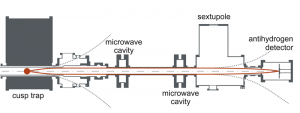Phase 2: HFS measurements using the Ramsey method of separated oscillatory fields
Using a single cavity, the width of the resonance curve is determined by the flight time of the atoms through the cavity, i.e. by the velocity of the antihydrogen atoms and the cavity length. To achieve higher resolution, Ramsey has invented a method using two cavities of length L separated by a distance D [13] (cf. Fig. 7). The width of the observed resonance lines is then by a factor D/L narrower. In our case, adding a second identical cavity of 10 cm length at a distance of 1 m would lead to a factor 10 reduction in line width. Since the antihydrogen beam is neither parallel nor mono-energetic, this will certainly result in a reduction of count rate, thus requiring significantly more time to achieve the potential resolution.
It is planned to build a second cavity during 2012 and to test the atomic beam line with one and two cavities with the hydrogen source during 2013 when CERN shuts down all accelerators to upgrade the LHC.

